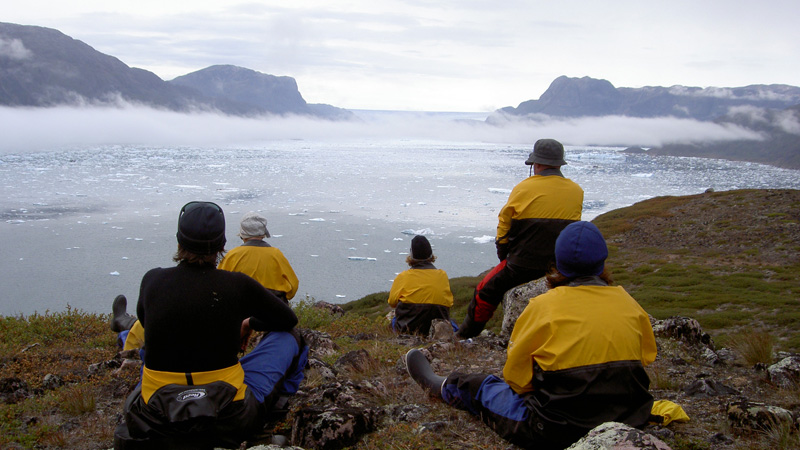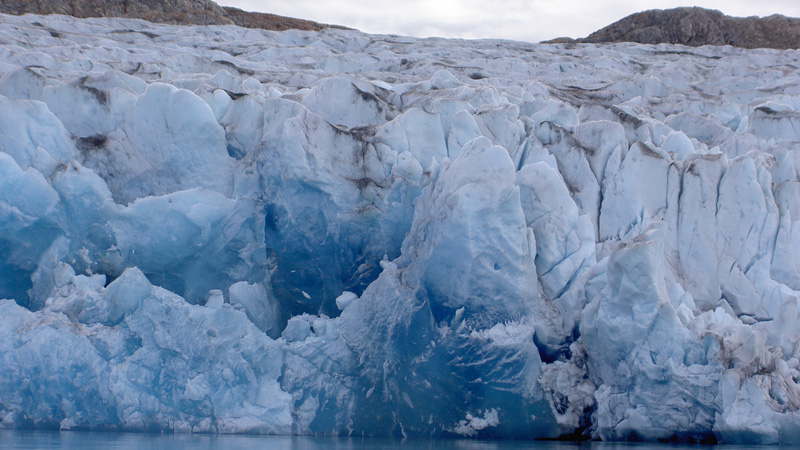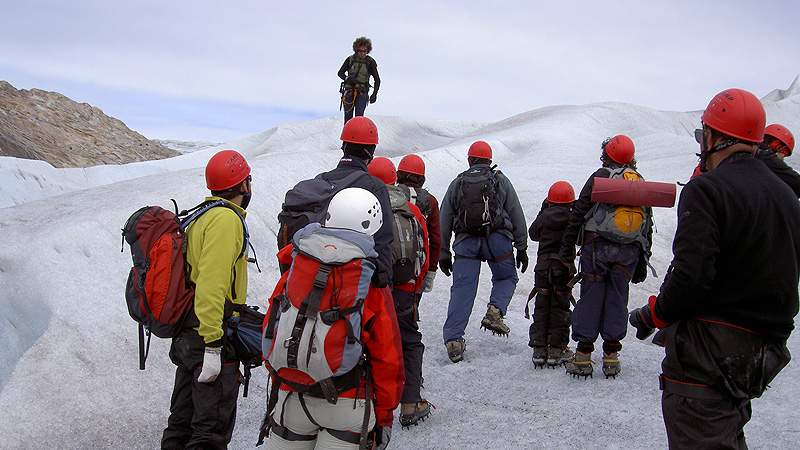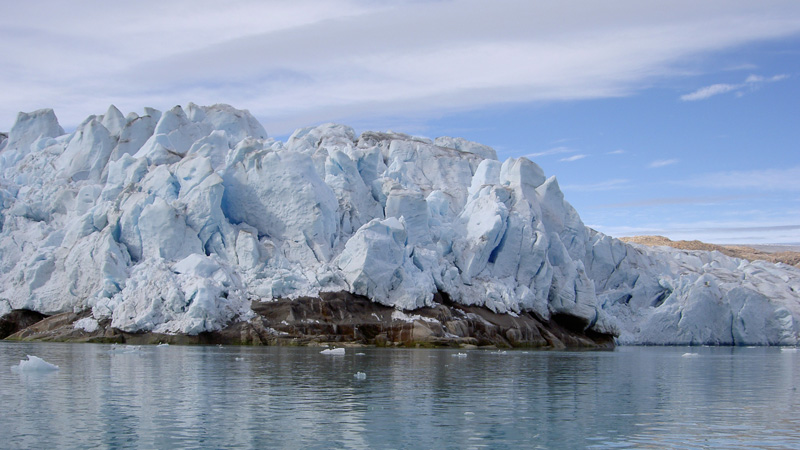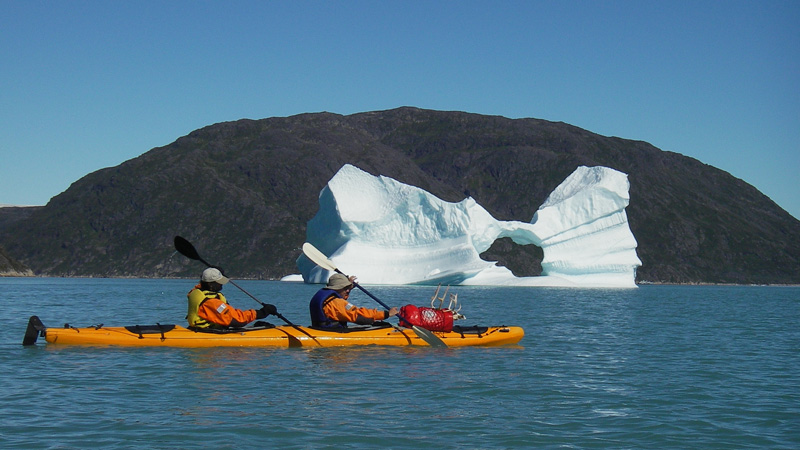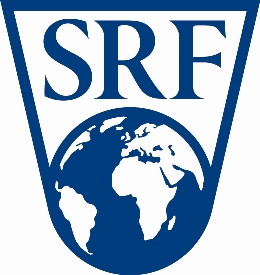Physical Condition
This trip has been planned so that anyone in reasonably good physical condition can participate; it is recommended that exercises for strengthening arms and building endurance are done for at least one month before the trip. The stages include 3 to 5 hours of rowing (15 to 20 km a day) with frequent stops and rest periods.
In the two-person kayaks, those in better shape will be paired with those who are a little less fit, so that the group can be balanced. The trip is not recommended only for those with serious back problems, due to the difficulties that can result from carrying the kayaks from the beach to the water and back.
We recommend that those who are in doubt about their physical abilities take a weekend kayak trip.
Difficulty
It is not absolutely necessary to have had prior experience in a kayak in order to participate in our trip, because the kayaks are stable, wide and safe, although if you haven't got any experience, we do recommend that you take a course and practise all you can before the trip. Travelling in these kayaks is not technically difficult, and is only done when conditions are favourable.
Those participants with prior experience in kayaking may choose to do the trip in an individual kayak (ask Tasermiut, South Greenland Expeditions before the trip).
The expedition is carried out in direct contact with Nature, without any contact with civilisation from the time we leave Narsaq until our return to this settlement.
Guide: South Greenland Expeditions
The trip will be accompanied by a veteran kayak guide, who has got several years' experience guiding kayak expeditions in hazardous environments.
The Guide’s job is to point the group in the right direction, to ensure all travellers’ safety and to solve any possible problems that may arise along the itinerary, making changes or adjustments if necessary. Activities such as setting up the tents in the camp or taking them down, making lunch or other shared activities will be everybody’s responsibility, including the guide’s.
Hostel - homes
Accommodation in hostel-homes will be made in a regular house, temporarily prepared to be used as hostels, with similar services, exclusively for the members of the group. We will use sleeping bags at night. Overnight stays at Hostel - Homes may be substituted by overnight stays at another local hostel.
Communication and Safety
Main mobile telephone networks can be reached in the cities and in some parts on the coast. The guide will carry a satellite phone throughout the entire trip.
At the start of the trip, the guide will share some basic tips on behaviour, safety and kayak self-rescue.
While travelling in the kayak, each participant will wear a special suit and a life jacket. The expedition is carried out in an area of fjords where there are hardly any waves, and the winds are usually very light. Travelling in the kayak is only done when the conditions are optimum, and with few exceptions, along the coast.
If there is an emergency, the guide will call a rescue boat, which will arrive within 2 to 3 hours –conditions permitting– to any point of the excursion and carry out an evacuation to the hostel or hospital in Narsaq if necessary.
Food
Breakfast: Coffee, tea, infusions, cocoa, powdered milk, biscuits, bread, jam, muesli and cereals.
Packed lunch: Bread, cheese, chorizo, salami, ham, paté, chocolate, nuts, biscuits, soup, hot tea…
Dinner: Meals cooked at the camp. Rice, pasta, fish, mashed potatoes and meat, sausages, bacon, chorizo, tuna, squid…
Northern Lights
The northern lights are one of the most wonderful of nature’s phenomena on our planet, a beautiful, delightful display of movement and light against the dark polar skies on clear, calm nights.
It is usually possible to witness the aurora in winter. Late summer, however, especially in September, is the best time of the year to watch it in Southern Greenland, which is famous for offering some of the best places to view this spectacular natural display. In July, there is more sunlight and therefore it is not so easy to see it, but in August it can be seen more often, and from September onwards, the aurora can be seen almost every day when the skies are clear.
Fishing and Fruit picking
All along the trip we will visit some very good areas to go fishing, especially for arctic salmon and cod. We do not provide fishing equipment. We therefore recommend you take it from your country or buy it at Narsaq.
Mushroom (Boletus Edulis) and blueberry picking is season dependent, although August is the best month. Mussel collecting will be easy near some of the camps and Ujarak’s hut, where there are plenty during the summer months.
Maps: We will use topographic maps 1:250.000
Weather
Weather in Greenland is very changeable. It is usually pleasant, but it is essential that you bring appropriate clothes for rainy weather. Temperatures are often more than 15ºC in July and between 5 º C and 10 º C in August. Mid-August nights are sometimes very cold. In September, temperatures are usually between 5ºC to 8ºC during the day and may reach minus 5ºC at night.
Ice conditions
Eastern Greenland draughts bring great amounts of ice from the Arctic Ocean, which, sometimes, block Southern Greenland from May to mid-June. We may also come across ice that makes navigation difficult in July, but it is rare. If this happens we would take an alternative route instead. In August, the icefield poses no special problems and the sea in the region is full of icebergs.
Pocket money
Greenland is one of the most expensive countries in the world. We recommend travellers bring approximately 450 - 1.000 crowns (50 - 130 Euros). You can purchase gifts and handicrafts at our Narsarsuaq office in Euros (It is not necessary to get extra crowns)
Passport and visa regulations
You must have a valid passport which expires no less than three months after your stay in Greenland. A visa is not necessary unless you come from a country where a visa is required to enter Denmark.
Vaccine
You do not need to have any injections for Greenland.
Language
Kalaallisut, the Western Greenlandic language, is the main language in Greenland. It is spoken by 40.000 people, which makes it the most important Inuit language in the world. Inuhumiutut is also spoken in the North, and Tunumiutut in the West Coast. Most people in Greenland speak some Danish, which is the second official language. Many speak English too, with various levels of fluency, especially young people. Greenlandic has an agglutinating structure. It belongs to the Inuit-Aleut family of languages, and it is spoken by people in different areas, from the Aleutian Islands up to the west coast in Greenland. It is of Asian origin, as is the Inuit race.
The country
Greenland is one of the most singular countries in the world: A huge island that holds a glacier measuring two million square kilometres in size, surrounded by a coastal mountainous belt, bathed by a sea which due to its Arctic climate remains frozen most of the year. Some 57.000 inhabitants, mostly Inuit depending on fishing, hunting and farming, live on the coast. Greenland is now semi-independent from Denmark, the colonising country. The most populated area is the west coast, where Nuuk – the capital of the country, with 15.000 inhabitants
– is located. Northern and Eastern Greenland are almost uninhabited.
Transport
Roads are almost non-existent, except in towns. The most common means of transport are therefore boats, planes, helicopters and dog sledges..
GROUP EQUIPMENT SUPPLIED BY SOUTH GREENLAND EXPEDITIONS FOR THE GROUP
CAMPING EQUIPMENT
* Tents
* Camping stoves and cooking accessories, kitchen utensils,…
* First-aid kit
COMMUNICATION
* The boats will be equipped with a radio to be used at sea.
* Mobile phone
* Iridium phone (Global signal)
* SPOT Satellite Messenger
ORIENTATION AND WEATHER CONDITIONS
• GPS
• Compasses
• Maps
TRAVELLING MATERIALS
* Very stable single and double kayaks
* 2 replacement paddlest
PERSONAL EQUIPMENT SUPPLIED BY SOUTH GREENLAND EXPEDITIONS
KAYAKING CLOTHING
• Semi-dry raincoat
• Semi-dry cordura trouser with latex closures
• Spray skirts
• Life jacket
• Paddling gloves
TRAVELLING MATERIALS
• 2 dry bags
• Paddle
• 1 bilge pump (per kayak)
RECOMMENDED PERSONAL EQUIPMENT NOT SUPPLIED BY SOUTH GREENLAND EXPEDITIONS
HEAD
• Fleece hat (or wollen)
• Sunglasses
• Sun cream (we recommend strong protection against UVA rays)
• Lip balm (with sun block)
• Mosquito head net (recommended if you come before mid August. It may be possible to purchase it at Narsarsuaq. Please book in advance.
• Peak cap (to use with the mosquito net)
BODY
• Waterproof jacket
• A pair of light waterproof trousers.
• Fleece jacket
• Fleece vest
• 2 long sleeve thermal shirts (one summer style and one winter style)
• 1 short sleeve thermal shirt
• 2 Thermal leggings (one summer style and one winter style)
• Comfortable trousers (to wear during the treks)
HANDS
• Neoprene gloves (recommended from mid August)
• Fleece gloves
FEET
• Waterproof trekking boots
• 4 pairs of socks
• Flip-flops or similar footwear (useful at the hostel, but not essential)
CAMPING EQUIPMENT
• Sleeping bag (if possible, synthetic and suitable for -10ºC). You may rent one at Narsarsuaq. Please contact Grönlandsresor first to confirm.
• Mattress pad. You may rent one at Narsarsuaq. Please contact Grönlandsreso first to confirm.
• Torch (if possible, head torch). If you come in August and onwards.
• Plate
• Cup
• Cutlery set
• Bottle
• Toilet bag and accessories (please bring biodegradable products)
BAGS
• Backpack, suitcase or big kit bag.
• Small bag (for one-day trips)
OTHERS
• Hiking poles (optional). You may rent one at Narsarsuaq. Please contact Grönlandsresor first to confirm.
Note:
This is not an exhaustive list. Please add toiletries, towel, travelling clothes, personal medication, and any other item you may need. When packing, please be aware of the limitations as far as space on boats is concerned, and keep in mind your own comfort. Try to carry as less weight as possible in a bag as small as possible. We will emphasize recommendations for luggage at the beginning of the journey.

